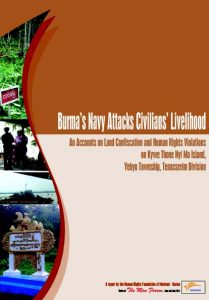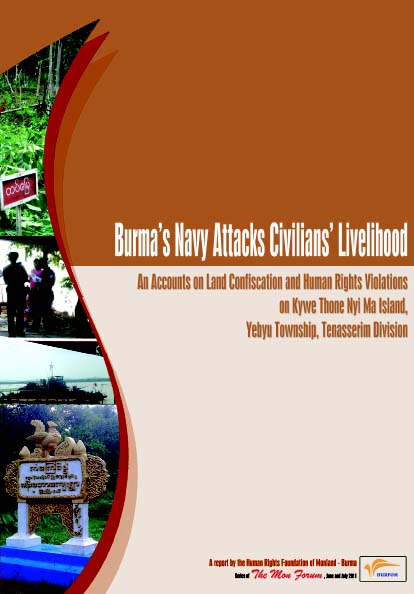Independent Mon News Agency – A Mon human rights group, the Human Rights Foundation of Monland (HURFOM), released a report today documenting Burmese Navy Battalion No. 43’s involvement in land confiscation on island called Kywe Thone Nyi Ma, where a large Mon village is located.

HURFOM’s Coordinator said, “We are quite sure that about 1,000 acres of land has already been confiscated. These lands are all on the island. The Navy took not only rubber plantations, but also plots of land in the villages. Now, they have also measured and marked another 3,000 acres of land.”
In the report, titled “Burma’s Navy Attacks Civilians’ Livelihood”, HURFOM explains that their human rights information documentation teams were able to access areas and interview local villagers who have lost their lands. Some families have migrated to Thailand since losing their lands, and human rights workers went to meet them in migrant workers’ camps.
Kwe Thone Nyi Ma village is on an island in southern Burma, and the villagers grow rubber and other orchard plantations outside of their communities. The majority of villagers rely on two main jobs: agriculture and fishing. The village has about 350 households in two sections, and the majority of them are Mon. The location of the village is near the Yadana gas pipeline, which connects an off-shore location in the Andaman Sea to Thailand’s border.
Burmese Navy Battalion No. 43 claims to have confiscated the land in order to build new military training grounds and barracks. But the villagers who have lost their lands say they do not believe this is the true reason for the confiscations.
Nai Ha Tay, age 60, said, “They just explained that they were taking our plantations for the construction of a training field for their army. But the length of the land they seized is too large, how will they build what they said they would? Like other places in Mon State where they have taken over, they confiscated the ready-to-use rubber plantations for their families and to provide for the army’s budget.”
Names of farmers who have lost land are listed in the 50-page-long report. The HURFOM Coordinator said, although the Navy force reached into the area in 2000, they did not have a plan to permanently deploy their force on the island. Just last year, the Navy made plans to deploy their battalion by increasing their troops and confiscating the villagers’ lands starting in December 2010.
The Mon human rights group also demands that the Mon political party which won seats in the 2010 elections provide protection for the farmers, and additionally that the International Labour Organization (ILO) and UN Special Rapporteur get involved in investigations about land confiscation issues and provide protection to the victims in the area.
There are no large armed rebel groups in the area, and the Navy battalion has no reason to launch new military operations in the area. Many Burmese Army forces from LIB No. 273 and LIB No. 282 are active in the area in order to attack a small Mon armed group and a Karen rebel force.
In 1995, after the New Mon State Party (NMSP) agreed to a ceasefire agreement with the Burmese military, all armed troops from the Mon National Liberation Army (MNLA) retreated back to the border area in the eastern part of the Ye-Tavoy motor road. Since then, there have been no threats posed to Burmese Army bases or the Yadana gas pipeline.
Prior to the 2010 elections in Burma, after the NMSP announced it would not accept the former military regime’s proposal to transform its troops to into a Border Guard Force, the ceasefire broke down. However, there has yet to be any serious fighting between NMSP troops and the Burmese Army.

